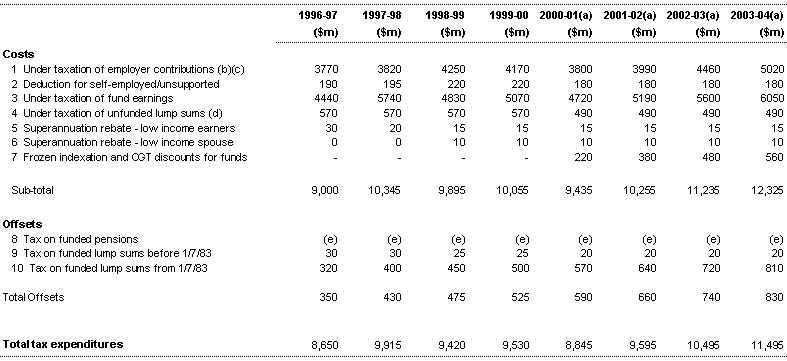B.1 Scope
This Appendix sets out the estimated tax expenditures related to the superannuation system for 1996-97 to 1999-2000 and forward projections for the following four years. It also briefly examines some conceptual issues relating to the interpretation of these estimates.
Superannuation in Australia is taxed at a concessional rate at three stages against a remuneration and saving benchmark:
- when contributions are made to a superannuation fund (by an employer or a member);
- when investments in superannuation funds earn income; and
- when unfunded superannuation benefits are paid out.
The overall taxation revenue raised remains concessional and the estimated shortfall of revenue over the shorter-term is calculated compared with the benchmark used. The benchmark has been summarised in chapter 3.
The calculation requires projections of contributions, earnings and eligible termination payments (ETPs). The estimates use Australian Taxation Office and RIMGROUP1 projections of contributions, earnings and payouts. They also assume that tax is collected from superannuation funds in the year in which the contributions and earnings occur.
B.2 Interpretation
The tax expenditure estimates represent the amount by which tax revenue is reduced in a particular year. The estimate of the tax expenditure in the forward projections is not necessarily indicative of the cost of the superannuation concessions over the long term:
- the taxes on superannuation pensions and lump sums could be expected to provide a greater offset to the cost of the under-taxation of contributions in future years when there are larger numbers of taxpayers drawing down their superannuation savings relative to the numbers in the accumulation phase; and
- the current superannuation tax concessions will have an (intended) impact on certain direct budgetary expenses in future years, particularly age pension payments.
Further, the estimates in Table B1 cannot be interpreted as a time series of the ongoing revenue savings that could be obtained if the superannuation concessions were eliminated. This is because the increase in tax revenue arising from the elimination of the tax expenditures with respect to a particular year would cause the superannuation tax base to be smaller for the next year. For example, if contributions and fund earnings in 1999-2000 were taxed according to the retirement benefits benchmark, superannuation fund assets, and hence fund earnings, would be lower in 2000-01 than if the concessional tax treatment had applied in the previous year. The cost of taxing fund earnings concessionally in 2000-01 would, in these circumstances, be lower than if the superannuation concessions had applied in 1999-2000.
In addition, the estimated cost of the tax expenditure on retirement and other employment termination benefits assumes no behavioural change involving either the superannuation portfolio composition or the saving rate. To the extent that this is an unrealistic assumption, the cost of the concessions will be overestimated.
Notwithstanding these caveats, the methodology used to cost tax expenditures in this Statement is considered to provide the best measure of the budgetary impact in any given year of removing existing tax concessions in that year.
B.3 Estimates
In comparing these estimates with those previously published, some changes will be apparent. One set of differences arises from a change in scope whereby the current estimates exclude `other (unfunded) termination payments', which are now included elsewhere as a separate tax expenditure (B2). Other differences arise from the change in CGT treatment incorporated in the benchmark, flowing on from taxation reform.
Further, there are changes arising from the revision of earnings estimates. The taxable earnings of superannuation funds are not readily predictable. A major reason is that it lies within the discretion of a fund manager to decide when any accrued capital gains of a fund are realised. In addition, the earnings series is intrinsically volatile, reflecting fluctuations in interest rates and dividends.
Fund earnings have been `smoothed out' for the forward projections as this is considered to provide a better indication of the cost of the tax expenditure over time.
The projected drop in tax expenditures in 2000-01 is a direct result of reductions in personal income tax rates under The New Tax System. There is also a more minor decrease included within the estimates from 1999-2000 onwards associated with the expected increase in superannuation contribution surcharge receipts, deriving from the change whereby fringe benefits affect the rate at which the surcharge applies.
Table B1: Estimated tax expenditures through superannuation tax concessions, 1996-97 to 2003-04

(a) Includes the new personal income tax rates under The New Tax System that became effective from 1 July 2000.
(b) Includes the revenue impact of the surcharge on superannuation contributions for high income earners.
(c) Includes the changes to the FBT which require employers to identify on group certificates the grossed-up taxable value of fringe benefits, starting in the 1999-2000 income year, for determining the liability for tax surcharges such as the superannuation contribution surcharge.
(d) Non-superannuation benefits have been removed to a separate tax expenditure (B2) and are not reported in this table.
(e) Indeterminate, but unlikely to be significant.
1 RIMGROUP is the model used by Treasury's Retirement and Income Modelling Unit to project superannuation fund contributions, earnings and payouts as well as related retirement income, social security and taxation aggregates.